当代国外翻译理论
- 格式:doc
- 大小:116.50 KB
- 文档页数:22
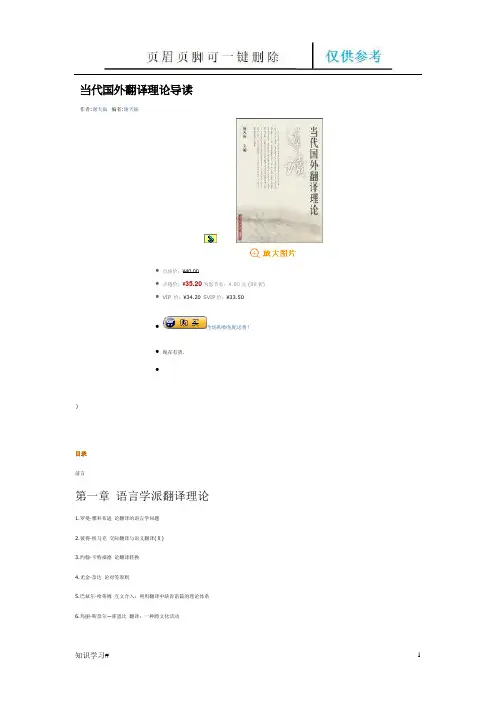
当代国外翻译理论导读作者:谢天振编者:谢天振•市场价:¥40.00•卓越价:¥35.20为您节省:4.80元 (88折)•VIP 价:¥34.20SVIP价:¥33.50•全场购物免配送费!•现在有货。
•)目录前言第一章语言学派翻译理论1.罗曼·雅科布逊论翻译的语言学问题2.彼得·纽马克交际翻译与语义翻译(Ⅱ)3.约翰·卡特福德论翻译转换4.尤金·奈达论对等原则5.巴兹尔·哈蒂姆互文介入:利用翻译中缺省语篇的理论体系6.玛丽·斯奈尔—霍恩比翻译:一种跨文化活动第二章阐释学派翻译理论7.乔治·斯坦纳阐释的步骤8.安托瓦纳·贝尔曼翻译及对异的考验第三章功能学派翻译理论9.凯瑟琳娜·莱斯翻译的抉择:类型、体裁及文本的个性10.汉斯·弗米尔翻译行为中的目的与委任11.克里斯汀娜·诺德目的、忠诚及翻译中的惯例第四章文化学派翻译理论12.詹姆斯·霍尔姆斯翻译学的名与实13.伊塔玛·埃文—佐哈翻译文学在文学多元系统中的地位14.吉迪恩·图里描述性翻译研究的理论基础15.安德烈·勒菲弗尔大胆妈妈的黄瓜:文学理论中的文本、系统和折射16.苏珊·巴斯奈特文化研究的翻译转向17.西奥·赫曼斯翻译研究及其新范式第五章解构学派翻译理论18.瓦尔特·本雅明译者的任务19.雅克·德里达巴别塔之旅20.保罗·德曼评本雅明的《译者的任务》21.劳伦斯·韦努蒂文化身份的塑造第六章女性主义翻译理论22.雪莉·西蒙翻译理论中的性别化立场23.劳丽·钱伯伦性别与翻译的隐喻24.巴巴拉·格达德女性主义话语/翻译的理论化25.冯·弗罗托女性主义翻译理论批评第七章后殖民翻译理论26.道格拉斯·罗宾逊后殖民研究与翻译研究27.特佳斯维妮·尼南贾纳翻译的定位28.盖亚特里·斯皮瓦克翻译的政治29.埃尔斯·维埃拉解放卡利班们——论食人说与哈罗德·德·坎波斯的超越/越界性创造诗学第八章苏东学派翻译理论30.安德烈·费奥多罗夫翻译理论的任务31.吉维·加切奇拉泽文学翻译中的创造性原则32.吉里·列维翻译是一个作选择的过程33.安娜·丽洛娃翻译研究的范畴Translation Theory(2007-09-29 14:13:41)标签:学习公社translationenglishtheoryTranslation TheoryBy Juan Daniel Pérez VallejoTranslation teacher,University of Cd. Del Carmen, Campeche, MexicoThe study of proper principle of translation is termed as translation theory. This theory, based on a solid foundation on understanding of how languages work, translation theory recognizes that different languages encode meaning in differing forms, yet guides translators to find appropriate ways of preserving meaning, while using the most appropriate forms of each language. Translation theory includes principles fortranslating figurative language, dealing with lexical mismatches, rhetorical questions, inclusion of cohesion markers, and many other topics crucial to good translation. Basically there are two competing theories of translation. In one,the predominant purpose is to express as exactly as possible the full force and meaning of every word and turn of phrase in the original, and in the other the predominant purpose is to produce a result that does not read like a translation at all, but rather moves in its new dress with the same ease as in its native rendering. In the hands of a good translator neither of these two approaches can ever be entirely ignored. Conventionally, it is suggested that in order to perform their job successfully, translators should meet three important requirements; they should be familiar with: the source languagethe target languagethe subject matterBased on this premise, the translator discovers the meaning behind the forms in the source language and does his best to produce the same meaning in the target language - using the forms and structures of the target language. Consequently, what is supposed to change is the form and the code and what should remain unchanged is the meaning and the message. (Larson, 1984)One of the earliest attempts to establish a set of major rules or principles to be referred to in literary translation was made by F rench translator and humanist Étienne Dolet, who in 1540 formulated the following fundamental principles of translation ("La Manière de Bien Traduire d’une Langue en Aultre"), usually regarded as providing rules of thumb for the practicing translator:The translator should understand perfectly the content and intention of the author whom he is translating. The principal way to reach it is reading all the sentences or the text completely so that you can give the idea that you want to say in the target language because the most important characteristic of this technique is translating the message as clearly and natural as possible. If the translation is for different countries besidesMexico, the translator should use the cultural words of that country. For example if he/she has to translate ”She is unloyal with her husband” in this country it can be translated as “Ella le pone los cuernos” but in Peru it can be translated as “Ella le pone los cachos”. In this case it is really important the cultural words beca use if the translator does not use them correctly the translation will be misunderstood. The translator should have a perfect knowledge of the language from which he is translating and an equally excellent knowledge of the language into which he is translating. At this point the translator must have a wide knowledge in both languages for getting the equivalence in the target language, because the deficiency of the knowledge of both languages will result in a translation without logic and sense. For example if you translate the following sentence “Are you interested in sports?” as “¿Estás interesado en deportes?” the translation is wrong since the idea of this question in English is “¿Practicas algún deporte?”The translator should avoid the tendency to translate word by word, because doing so is to destroy the meaning of the original and to ruin the beauty of the expression_r. This point is very important and one of which if it is translated literally it can transmit another meaning or understanding in the translation.For example in the sentence.- “In this war we have to do or die”, if we translate literally “En esta guerra tenemos que hacer o morir” the message is unclear. The idea is, (.) “En esta guerra tenemos que vencer o morir.”The translator should employ the forms of speech in common usage. The translator should bear in mind the people to whom the translation will be addressed and use words that can be easily understood.Example. “They use a sling to lift the pipes” if the translation is to be read by specialists we would translate it “Utilizan una eslinga para levantar la tubería”. If the text is to be read by people who are not specialists we would rather translate it “Utilizan una cadena de suspension para levantar los tubos”.。
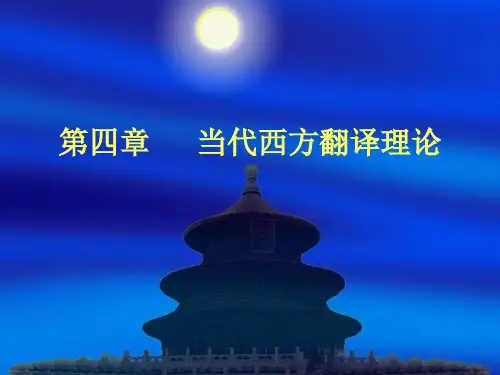
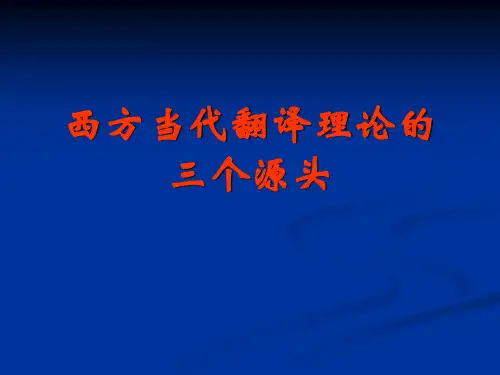
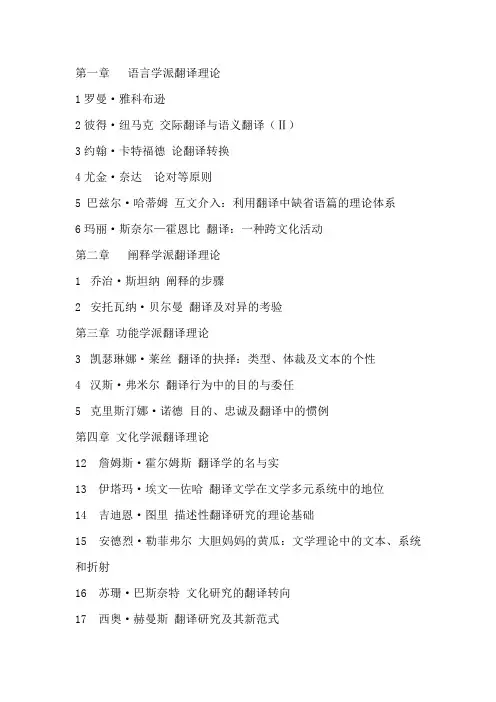
1罗曼·雅科布逊2彼得·纽马克交际翻译与语义翻译(Ⅱ)3约翰·卡特福德论翻译转换4尤金·奈达论对等原则5 巴兹尔·哈蒂姆互文介入:利用翻译中缺省语篇的理论体系6玛丽·斯奈尔—霍恩比翻译:一种跨文化活动第二章阐释学派翻译理论1乔治·斯坦纳阐释的步骤2安托瓦纳·贝尔曼翻译及对异的考验第三章功能学派翻译理论3凯瑟琳娜·莱丝翻译的抉择:类型、体裁及文本的个性4汉斯·弗米尔翻译行为中的目的与委任5克里斯汀娜·诺德目的、忠诚及翻译中的惯例第四章文化学派翻译理论12 詹姆斯·霍尔姆斯翻译学的名与实13 伊塔玛·埃文—佐哈翻译文学在文学多元系统中的地位14 吉迪恩·图里描述性翻译研究的理论基础15 安德烈·勒菲弗尔大胆妈妈的黄瓜:文学理论中的文本、系统和折射16 苏珊·巴斯奈特文化研究的翻译转向17 西奥·赫曼斯翻译研究及其新范式18 瓦尔特·本雅明译者的任务19 雅克·德里达巴别塔之旅20.保罗·德曼评本雅明的《译者的任务》21.劳伦斯·韦努蒂文化身份的塑造第六章女性主义翻译理论22.雪莉·西蒙翻译理论中的性别化立场23.劳丽·钱伯伦性别与翻译的隐喻24.巴巴拉·格达德女性主义话语/翻译的理论化25.冯·弗罗托女性主义翻译理论批评第七章后殖民翻译理论26.道格拉斯·罗宾逊后殖民研究与翻译研究27.特佳斯维妮·尼南贾纳翻译的定位28.盖亚特里·斯皮瓦克翻译的政治29.埃尔斯·维埃拉解放卡利班们——论食人说与哈罗德·德·坎波斯的超越/越界性创造诗学第八章苏东学派翻译理论30.安德烈·费奥多罗夫翻译理论的任务31.吉维·加切奇拉泽文学翻译中的创造性原则32.吉里·列维翻译是一个作选择的过程33.安娜·丽洛娃翻译研究的范畴6Roman Jakobson论翻译的语言学问题“On Linguistic Aspectsof Translation”布拉格语言学派创始人罗曼·雅科布逊1959年发表的《论翻译的语言学问题》首先将语言学、符号学引进了翻译学,他把语言分为“语内翻译(Intralingual Translation)、语际翻译(Interlingual Translation) 和符际翻译(Intersemiotic Translation)”(三分法理论)。
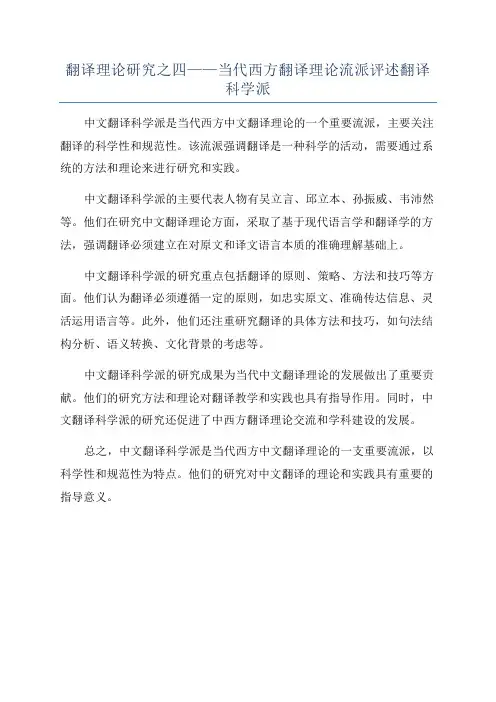
翻译理论研究之四——当代西方翻译理论流派评述翻译
科学派
中文翻译科学派是当代西方中文翻译理论的一个重要流派,主要关注翻译的科学性和规范性。
该流派强调翻译是一种科学的活动,需要通过系统的方法和理论来进行研究和实践。
中文翻译科学派的主要代表人物有吴立言、邱立本、孙振威、韦沛然等。
他们在研究中文翻译理论方面,采取了基于现代语言学和翻译学的方法,强调翻译必须建立在对原文和译文语言本质的准确理解基础上。
中文翻译科学派的研究重点包括翻译的原则、策略、方法和技巧等方面。
他们认为翻译必须遵循一定的原则,如忠实原文、准确传达信息、灵活运用语言等。
此外,他们还注重研究翻译的具体方法和技巧,如句法结构分析、语义转换、文化背景的考虑等。
中文翻译科学派的研究成果为当代中文翻译理论的发展做出了重要贡献。
他们的研究方法和理论对翻译教学和实践也具有指导作用。
同时,中文翻译科学派的研究还促进了中西方翻译理论交流和学科建设的发展。
总之,中文翻译科学派是当代西方中文翻译理论的一支重要流派,以科学性和规范性为特点。
他们的研究对中文翻译的理论和实践具有重要的指导意义。
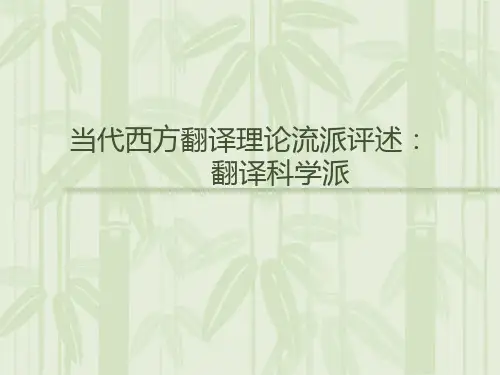
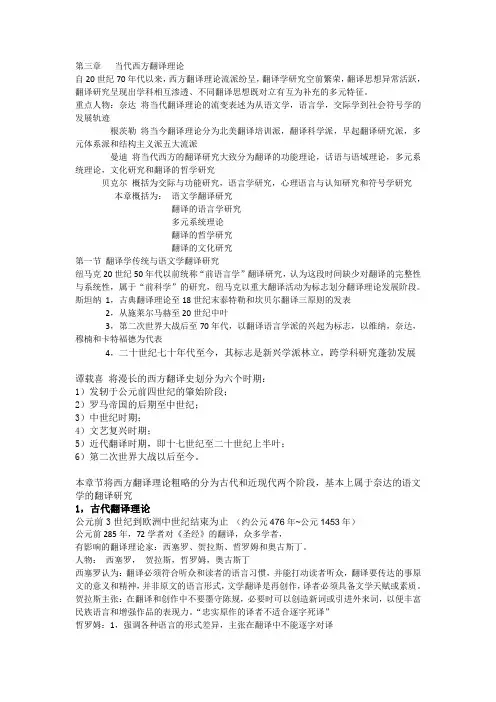
第三章当代西方翻译理论自20世纪70年代以来,西方翻译理论流派纷呈,翻译学研究空前繁荣,翻译思想异常活跃,翻译研究呈现出学科相互渗透、不同翻译思想既对立有互为补充的多元特征。
重点人物:奈达将当代翻译理论的流变表述为从语文学,语言学,交际学到社会符号学的发展轨迹根茨勒将当今翻译理论分为北美翻译培训派,翻译科学派,早起翻译研究派,多元体系派和结构主义派五大流派曼迪将当代西方的翻译研究大致分为翻译的功能理论,话语与语域理论,多元系统理论,文化研究和翻译的哲学研究贝克尔概括为交际与功能研究,语言学研究,心理语言与认知研究和符号学研究本章概括为:语文学翻译研究翻译的语言学研究多元系统理论翻译的哲学研究翻译的文化研究第一节翻译学传统与语文学翻译研究纽马克20世纪50年代以前统称“前语言学”翻译研究,认为这段时间缺少对翻译的完整性与系统性,属于“前科学”的研究,纽马克以重大翻译活动为标志划分翻译理论发展阶段。
斯坦纳1,古典翻译理论至18世纪末泰特勒和坎贝尔翻译三原则的发表2,从施莱尔马赫至20世纪中叶3,第二次世界大战后至70年代,以翻译语言学派的兴起为标志,以维纳,奈达,穆楠和卡特福德为代表4,二十世纪七十年代至今,其标志是新兴学派林立,跨学科研究蓬勃发展谭载喜将漫长的西方翻译史划分为六个时期:1)发轫于公元前四世纪的肇始阶段;2)罗马帝国的后期至中世纪;3)中世纪时期;4)文艺复兴时期;5)近代翻译时期,即十七世纪至二十世纪上半叶;6)第二次世界大战以后至今。
本章节将西方翻译理论粗略的分为古代和近现代两个阶段,基本上属于奈达的语文学的翻译研究1,古代翻译理论公元前3世纪到欧洲中世纪结束为止(约公元476年~公元1453年)公元前285年,72学者对《圣经》的翻译,众多学者,有影响的翻译理论家:西塞罗、贺拉斯、哲罗姆和奥古斯丁。
人物:西塞罗,贺拉斯,哲罗姆,奥古斯丁西塞罗认为:翻译必须符合听众和读者的语言习惯,并能打动读者听众,翻译要传达的事原文的意义和精神,并非原文的语言形式,文学翻译是再创作,译者必须具备文学天赋或素质。

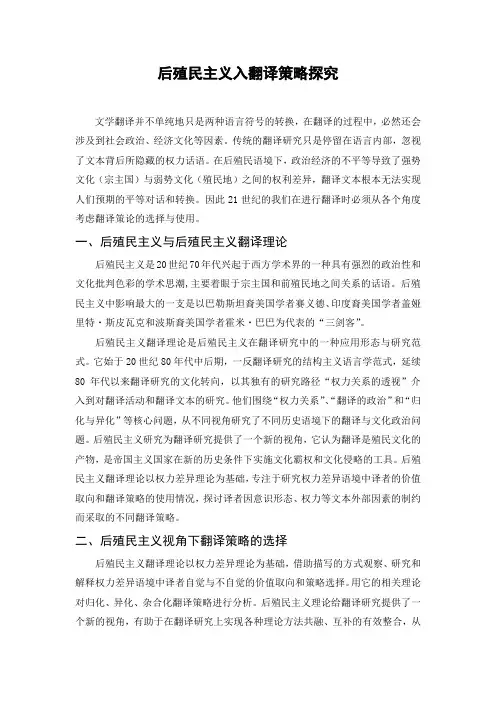
后殖民主义入翻译策略探究文学翻译并不单纯地只是两种语言符号的转换,在翻译的过程中,必然还会涉及到社会政治、经济文化等因素。
传统的翻译研究只是停留在语言内部,忽视了文本背后所隐藏的权力话语。
在后殖民语境下,政治经济的不平等导致了强势文化(宗主国)与弱势文化(殖民地)之间的权利差异,翻译文本根本无法实现人们预期的平等对话和转换。
因此21世纪的我们在进行翻译时必须从各个角度考虑翻译策论的选择与使用。
一、后殖民主义与后殖民主义翻译理论后殖民主义是20世纪70年代兴起于西方学术界的一种具有强烈的政治性和文化批判色彩的学术思潮,主要着眼于宗主国和前殖民地之间关系的话语。
后殖民主义中影响最大的一支是以巴勒斯坦裔美国学者赛义德、印度裔美国学者盖娅里特·斯皮瓦克和波斯裔美国学者霍米·巴巴为代表的“三剑客”。
后殖民主义翻译理论是后殖民主义在翻译研究中的一种应用形态与研究范式。
它始于20世纪80年代中后期,一反翻译研究的结构主义语言学范式,延续80年代以来翻译研究的文化转向,以其独有的研究路径“权力关系的透视”介入到对翻译活动和翻译文本的研究。
他们围绕“权力关系”、“翻译的政治”和“归化与异化”等核心问题,从不同视角研究了不同历史语境下的翻译与文化政治问题。
后殖民主义研究为翻译研究提供了一个新的视角,它认为翻译是殖民文化的产物,是帝国主义国家在新的历史条件下实施文化霸权和文化侵略的工具。
后殖民主义翻译理论以权力差异理论为基础,专注于研究权力差异语境中译者的价值取向和翻译策略的使用情况,探讨译者因意识形态、权力等文本外部因素的制约而采取的不同翻译策略。
二、后殖民主义视角下翻译策略的选择后殖民主义翻译理论以权力差异理论为基础,借助描写的方式观察、研究和解释权力差异语境中译者自觉与不自觉的价值取向和策略选择。
用它的相关理论对归化、异化、杂合化翻译策略进行分析。
后殖民主义理论给翻译研究提供了一个新的视角,有助于在翻译研究上实现各种理论方法共融、互补的有效整合,从而推动翻译研究的进一步发展。
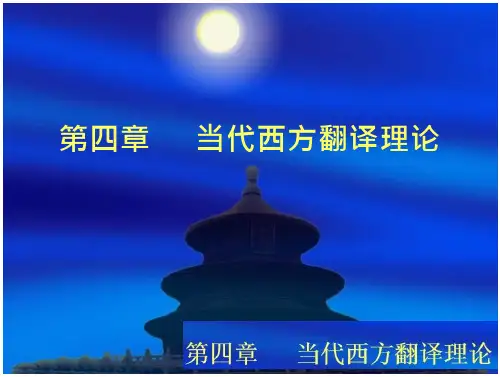
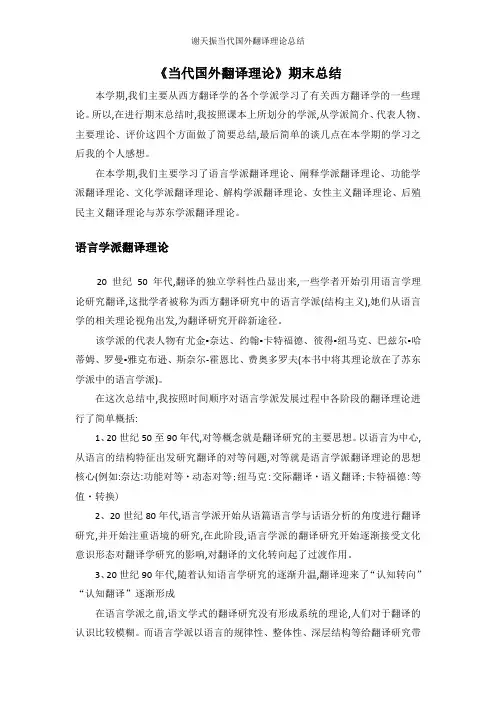
《当代国外翻译理论》期末总结本学期,我们主要从西方翻译学的各个学派学习了有关西方翻译学的一些理论。
所以,在进行期末总结时,我按照课本上所划分的学派,从学派简介、代表人物、主要理论、评价这四个方面做了简要总结,最后简单的谈几点在本学期的学习之后我的个人感想。
在本学期,我们主要学习了语言学派翻译理论、阐释学派翻译理论、功能学派翻译理论、文化学派翻译理论、解构学派翻译理论、女性主义翻译理论、后殖民主义翻译理论与苏东学派翻译理论。
语言学派翻译理论20 世纪50 年代,翻译的独立学科性凸显出来,一些学者开始引用语言学理论研究翻译,这批学者被称为西方翻译研究中的语言学派(结构主义),她们从语言学的相关理论视角出发,为翻译研究开辟新途径。
该学派的代表人物有尤金▪奈达、约翰▪卡特福德、彼得▪纽马克、巴兹尔▪哈蒂姆、罗曼▪雅克布逊、斯奈尔-霍恩比、费奥多罗夫(本书中将其理论放在了苏东学派中的语言学派)。
在这次总结中,我按照时间顺序对语言学派发展过程中各阶段的翻译理论进行了简单概括:1、20世纪50至90年代,对等概念就是翻译研究的主要思想。
以语言为中心,从语言的结构特征出发研究翻译的对等问题,对等就是语言学派翻译理论的思想核心(例如:奈达:功能对等・动态对等;纽马克:交际翻译・语义翻译;卡特福德:等值・转换)2、20世纪80年代,语言学派开始从语篇语言学与话语分析的角度进行翻译研究,并开始注重语境的研究,在此阶段,语言学派的翻译研究开始逐渐接受文化意识形态对翻译学研究的影响,对翻译的文化转向起了过渡作用。
3、20世纪90年代,随着认知语言学研究的逐渐升温,翻译迎来了“认知转向”“认知翻译”逐渐形成在语言学派之前,语文学式的翻译研究没有形成系统的理论,人们对于翻译的认识比较模糊。
而语言学派以语言的规律性、整体性、深层结构等给翻译研究带来了理性思维。
语言学派的翻译理论家对翻译的语言学研究更具独立学科的性质。
翻译研究对等值的讨论不再拘泥于内容与功能,还考虑到文学翻译中的形式与文学性,进而发展为解决多层次、多类型的语际转换问题。
当代国外翻译理论主要翻译流派及学者语言学派翻译理论Roman Jakobson 罗曼·雅科布逊原籍俄罗斯,后移居捷克,最后加入美国国籍Peter Newmark 彼得·纽马克J. C. Catford 约翰·卡特福特,英国Eugene Nida尤金·奈达,美国Basil Hatim巴兹尔·哈蒂姆Mary Snell-Hornby玛丽·斯奈尔—霍恩比阐释学派翻译理论George Steiner乔治·斯坦纳,英国Antoine Berman安托瓦纳·贝尔曼,法国功能学派翻译理论Katharina Reiss 凯瑟琳娜·莱斯,德国Hans Vermeer 汉斯·弗米尔,德国Christiane Nord 克里斯汀娜·诺德,德国文化学派翻译理论James Holmes 詹姆斯·霍姆斯Itamar Even-Zohar伊塔玛·埃文—佐哈,以色列Gideon Toury 吉迪恩·图里AndréLefevere安德烈·勒菲弗尔Susan Bassnett苏珊·巴斯奈特,英国Theo Hermans西奥·赫曼斯,荷兰解构学派翻译理论Walter Benjamin瓦尔特·本雅明,德国J. Jacques Derrida 雅克·德里达,法国Paul de Man保罗·德曼,美国Lawrence Venuti劳伦斯·韦努蒂,美籍意大利翻译理论家女性主义翻译理论Sherry Simon雪莉·西蒙,加拿大Lori Chamberlain劳丽·钱伯伦Barbara Godard 巴巴拉·格达德,加拿大Luise von Flotow 路易斯·冯·弗罗托后殖民主义翻译理论Douglas Robinson 道格拉斯·罗宾逊,美国Tejaswini Niranjana 特佳斯维妮·尼南贾纳,印度Gayatri Chakravorty Spivak 盖亚特里·斯皮瓦克,印度裔美学Else Ribeiro Pires Vieira埃尔斯·丽贝罗·皮尔斯·维埃拉,巴西苏东学派翻译理论安德烈·费道罗夫吉维·加切奇拉泽吉里·列维安娜·里洛娃。
翻译学必读1语文和诠释学派二十世纪之前的翻译理论被纽马克(1981)称为翻译研究的‘前语言学时期’,人们围绕‘word-for-word’和‘sense-for-sense’ 展开激烈的讨论,核心是‘忠实’,‘神似’和‘真理’。
典型的代表有John Dryden, Tytler等,而Barnard, Steiner等人则是在他们的基础上进一步发展。
2语言学派Jacobson(1959)提出意义对等的问题,随后的二十多当年,学界围绕这个问题进行了研究。
奈达(1969)采取了转换语法模式,运用“科学(奈达语)”的方法来分析他翻译《圣经》过程中的意义处理问题。
奈达提出的形式对等说、动态对等说和等效原则都是将注意力集中在受众一方。
纽马克信奉的是语义翻译和交际翻译,即重视翻译中的语义和交际方面。
3话语分析Discourse Analysis(critical discourse analysis批评话语分析functional discourse analysis功能语篇分析Discourse analysis theory话语分析理论Discourse Analysis for Interpreters翻译专业演说分析Pragmatics & Discourse Analysis语用学positive discourse analysis积极话语分析rhetorical or discourse analysis语篇分析Pragmatics and Discourse Analysis语用学Mediated discourse analysis中介话语分析二十世纪七十年代到九十年代,作为应用语言学领域的一个分支,话语分析经历了产生和发展壮大的过程,其理论背景来自(韩礼德)的系统功能语法。
今天,话语分析的方法已经逐步运用到翻译研究中。
House(1997)提出的翻译质量模型就是基于韩礼德的理论,他吸收了其中的语域分析方法;Baker(1992) 则为培养译员提供了话语分析和语用分析的范本;Hatim 和Mason(1997)将语域研究拓展到语用和符号学角度~4目的学派目的学派于二十世纪七、八十年代在德国兴起,是从静态的语言学、语言类型学中剥离出来的。
当代西方翻译研究的三大突破,两大转向三大突破1)20世纪50年代以来的西方翻译研究开始从一般层面上的对两种语言转换的技术问题的研究,也即从“怎么译”的问题,深入到了对翻译行为本身的深层探究。
提出了语音、语法、语义等一系列的等值问题。
当代西方翻译研究中的等值论等研究,虽然有它的局限,但它对翻译所作的微观分析,无疑使人们对翻译的过程和目标,看得更加清楚了,更加透彻了。
2)当代西方的翻译研究不再局限于翻译文本本身的研究,而把目光投射到了译作的发起者、翻译文本的操作者和接受者身上。
它借鉴了接受美学、读者反应等理论,跳出了对译文与原文之间一般字面上的忠实与否之类问题的考察,而注意到了译作在新的文化语境里的传播与接受,注意到了翻译作为一种跨文化的传递行为的最终目的和效果,还注意到了译者在这整个的翻译过程中所起的作用。
3)当代翻译研究的最大突破还表现在把翻译放到一个宏大的文化语境中去审视。
研究者开始关注翻译研究中语言学科以外的其他学科的因素。
他们一方面认识到翻译研究作为一门独立学科的性质,另一方面又看到了翻译研究这门学科的多学科形式,注意到它不仅与语言学,而且还与文艺学、哲学甚至社会学、心理学等学科都有密不可分的关系。
但是翻译研究最终关注的当然还是文本在跨文化交际和传递中所涉及的一系列文化问题,诸如文化误读、信息增添、信息失落等。
两大转向1)语言学派的转向2)从文化层面来审视翻译的转向当代西方翻译理论语言学派理论从20世纪50年代起,西方出现了一批运用现代语言学的结构理论、转换生成理论、功能理论、话语理论、信息论等理论的学者,他们把翻译问题纳入到语言学的研究领域,从比较语言学、应用语言学、社会语言学、语义学、符号学、交际学等角度,提出了相对严谨的翻译理论和方法,开拓出了翻译研究的新领域,给传统的翻译研究注入了新的内容。
他们是当代西方翻译史上名副其实的翻译理论家,其中最主要的代表人物有:雅可布逊(Roman Jakobson)尤金·奈达(Eugen A. Nida)卡特福特(J.C. Catford)彼得·纽马克(Peter Newmark)从严格意义上而言,是这批学者对翻译问题的学术探讨,揭开了当代西方翻译史上的理论层面。
“当代西方翻译理论”新解目前,在“当代西方翻译理论”这一概念涵盖的时间范围上,译学界有着不同的理解与表述。
事实上,目前在中国出版发行的、以“当代”冠名的翻译理论著作所涉内容也大都是西方的。
如此一来,对“当代西方翻译理论”这一概念的不同表述进行界定,然后再以此为据,从翻译规范的视角出发,重新给予界定,提出一种相对周全的观点就显得必要了。
本文拟首先厘清译学界对“当代西方翻译理论”这一概念的不同表述,以及与之相关的“现代”和“当代”两个时间概念之间的关系,然后在此基础上,通过辨证分析后提出将“当代西方翻译理论”视为一个动态概念,即“当代西方翻译理论”始终指近十年的西方翻译理论,以期加深人们对“当代西方翻译理论”的认知和了解。
一、对“当代西方翻译理论”起始时间的不同表述在译学界,与大量侧重翻译技能的翻译教材相比,有关当代翻译理论的专著及相关论文屈指可数,即使有也大都是对西方有关专著的“译介、验证或应用”等。
比如在专著方面,仅先后有许钧和袁筱一编著的《当代法国翻译理论》、郭建中编著的《当代美国翻译理论》、廖七一编著的《当代西方翻译理论探索》、根茨勒(Edwin Gentzler)编著的修订版《当代翻译理论》(第二版修订本)(ContemporaryTranslation Theories。
Revised Second Edition)以及廖七一等编著的《当代英国翻译理论》等不多的几本。
至于有关论述当代翻译理论的论文,截至2009年底,笔者从中国期刊全文数据库中也只能检索到二十余篇,且大都或述或评,文中所涉及的内容基本上都涵盖在以上这几本专著里面,“而对其进行反思、质疑、证伪、发展的却很少”。
而且这些有限的专著和相关论文中,著作者们对“当代西方翻译理论”这一概念所表述的时间范围是只言片语、模糊的,甚至是互不统一的。
归纳起来,主要有如下三种观点:1.第一种观点认为“当代西方翻译理论”的起点应该是在20世纪初。
当代国外翻译理论导读作者:谢天振编者:谢天振•市场价:¥40.00•卓越价:¥35.20为您节省:4.80元(88折)•VIP 价:¥34.20 SVIP价:¥33.50•全场购物免配送费!•现在有货。
•)目录前言第一章语言学派翻译理论1.罗曼·雅科布逊论翻译的语言学问题2.彼得·纽马克交际翻译与语义翻译(Ⅱ)3.约翰·卡特福德论翻译转换4.尤金·奈达论对等原则5.巴兹尔·哈蒂姆互文介入:利用翻译中缺省语篇的理论体系6.玛丽·斯奈尔—霍恩比翻译:一种跨文化活动第二章阐释学派翻译理论7.乔治·斯坦纳阐释的步骤8.安托瓦纳·贝尔曼翻译及对异的考验第三章功能学派翻译理论9.凯瑟琳娜·莱斯翻译的抉择:类型、体裁及文本的个性10.汉斯·弗米尔翻译行为中的目的与委任11.克里斯汀娜·诺德目的、忠诚及翻译中的惯例第四章文化学派翻译理论12.詹姆斯·霍尔姆斯翻译学的名与实13.伊塔玛·埃文—佐哈翻译文学在文学多元系统中的地位14.吉迪恩·图里描述性翻译研究的理论基础15.安德烈·勒菲弗尔大胆妈妈的黄瓜:文学理论中的文本、系统和折射16.苏珊·巴斯奈特文化研究的翻译转向17.西奥·赫曼斯翻译研究及其新范式第五章解构学派翻译理论18.瓦尔特·本雅明译者的任务19.雅克·德里达巴别塔之旅20.保罗·德曼评本雅明的《译者的任务》21.劳伦斯·韦努蒂文化身份的塑造第六章女性主义翻译理论22.雪莉·西蒙翻译理论中的性别化立场23.劳丽·钱伯伦性别与翻译的隐喻24.巴巴拉·格达德女性主义话语/翻译的理论化25.冯·弗罗托女性主义翻译理论批评第七章后殖民翻译理论26.道格拉斯·罗宾逊后殖民研究与翻译研究27.特佳斯维妮·尼南贾纳翻译的定位28.盖亚特里·斯皮瓦克翻译的政治29.埃尔斯·维埃拉解放卡利班们——论食人说与哈罗德·德·坎波斯的超越/越界性创造诗学第八章苏东学派翻译理论30.安德烈·费奥多罗夫翻译理论的任务31.吉维·加切奇拉泽文学翻译中的创造性原则32.吉里·列维翻译是一个作选择的过程33.安娜·丽洛娃翻译研究的范畴Translation Theory(2007-09-29 14:13:41)标签:学习公社translationenglishtheoryTranslation TheoryBy Juan Daniel Pérez VallejoTranslation teacher,University of Cd. Del Carmen, Campeche, MexicoThe study of proper principle of translation is termed as translation theory. This theory, based on a solid foundation on understanding of how languages work, translation theory recognizes that different languages encode meaning in differing forms, yet guides translators to find appropriate ways of preserving meaning, while using the most appropriate forms of each language. Translation theory includes principles for translating figurative language, dealing with lexical mismatches, rhetorical questions, inclusion of cohesion markers, and many other topics crucial to good translation. Basically there are two competing theories of translation. In one,the predominant purpose is to express as exactly as possible the full force and meaning of everyword and turn of phrase in the original, and in the other the predominant purpose is to produce a result that does not read like a translation at all, but rather moves in its new dress with the same ease as in its native rendering. In the hands of a good translator neither of these two approaches can ever be entirely ignored. Conventionally, it is suggested that in order to perform their job successfully, translators should meet three important requirements; they should be familiar with: the source languagethe target languagethe subject matterBased on this premise, the translator discovers the meaning behind the forms in the source language and does his best to produce the same meaning in the target language - using the forms and structures of the target language. Consequently, what is supposed to change is the form and the code and what should remain unchanged is the meaning and the message. (Larson, 1984)One of the earliest attempts to establish a set of major rules or principles to be referred to in literary translation was made by French translator and humanist Étienne Dolet, who in 1540 f ormulated the following fundamental principles of translation ("La Manière de Bien Traduire d’une Langue en Aultre"), usually regarded as providing rules of thumb for the practicing translator:The translator should understand perfectly the content and intention of the author whom he is translating. The principal way to reach it is reading all the sentences or the text completely so that you can give the idea that you want to say in the target language because the most important characteristic of this technique is translating the message as clearly and natural as possible. If the translation is for different countries besides Mexico, the translator should use the cultural words of that country. For example if he/she has to translate ”She is unloyal with her husband” in this country it can be translated as “Ella le pone los cuernos” but in Peru it can be translated as “Ella le pone los cachos”. In this case it is really important the cultural words because if the translator does not use them correctly the translation will be misunderstood.The translator should have a perfect knowledge of the language from which he is translating and an equally excellent knowledge of the language into which he is translating. At this point the translator must have a wide knowledge in both languages for getting the equivalence in the target language, because the deficiency of the knowledge of both languages will result in a translation without logic and sense. For example if you translate the following sentence “Are you interested in sports?” as “¿Estás interesado en deportes?” the translation is wrong since the idea of this question in English is “¿Practicas algún deporte?”The translator should avoid the tendency to translate word by word, because doing so is to destroy the meaning of the original and to ruin the beauty of the expression_r. This point is very important and one of which if it is translated literally it can transmit another meaning or understanding in the translation.For example in the sentence.- “In this war we have to do or die”, if we translate literally “En esta guerra tenemos que hacer o morir” the message is unclear. The idea is, (.) “En esta guerra tenemos que vencer o morir.”The translator should employ the forms of speech in common usage. The translator should bear in mind the people to whom the translation will be addressed and use words that can be easily understood.Example. “They use a sling to lift the pipes” if the translation is to be read by specialists we would translate it “Utilizan una esling a para levantar la tubería”. If the text is to be read by people who are not specialists we would rather translate it “Utilizan una cadena de suspension para levantar los tubos”.Flip to Text Version La Trobe UniversityHarry AvelingA Short History of Western Translation Theory1. Traditional Translation TheoriesThere is a continuity of intellectual expression from Ancient Greece, Rome, the Middle Ages, through to the Renaissance, the Reformation, and the rise of the early European nation states. The central language of scholars and other readers was Latin, while the core of this tradition was classicalliterature and Judeo-Christianity. There was a profusion of economic and political contacts throughout Europe and the Middle East, and this must have involved an abundance of linguistic transactions. Nevertheless, Lefevere"s words provide an accurate background to understanding the social position of the subjects of traditional translation theory: "In such a culture, translations were not primarily read for information or the mediation of the foreign text. They were produced and read as exercises, first pedagogical exercises, and later on, as exercises in cultural appropriation - in the conscious and controlled usurpation of authority." (Lefevere 1990: 16).2. German RomanticismAt the beginning of the nineteenth century, a second, more philosophical and less empirical, formation began to open within discourses on translation theory (Munday 2001: 27). This formation was connected, in one direction, with the rise of philology as a university discipline, and in another with the literary movement of Romanticism. Philology provided a range of new and exotic texts and allowed the experts to produce translations aimed primarily at other experts, not the general culture of which these scholars were a part (Lefevere 1990: 22). Romanticism exalted the translator "as a creative genius in his own right, in touch with the genius of his original and enriching the literature and language into which he is translating" (Bassnett-McGuire 1980: 65). The stress on both the original author and the translator as being artists was not part of traditional discourse formations.3. The Early and Middle Twentieth CenturyDiscussion in English of translation theory during the first half of the twentieth century continued to be dominated by the themes of Victorian discourse on translation, "literalness, archaizing, pedantry and the production of a text of second-rate literary merit for an elite minority" (Bassnett-McGuire 1980: 73). In his list of major contributors to the area of translation theory, Steiner recognises only the names of Dryden, Quine and Pound among English-speakers. Quine and Pound both belong to the twentieth century and challenged the dominant discourse. Willard V. Quine (b. 1908), a major American philosopher, wrote on "the indeterminacy of translation" within the field of linguistic philosophy (Quine 1960). Ezra Pound (1885-1972) was a poet and critic. Ronnie Apter has argued that Pound made three major innovations to thinking about "the nature and intent of literary translation…he discarded the Victorian pseudo-archaic translation diction; he regarded each translation as a necessarily limited criticism of the original poem; and he regarded good translations as new poems in their own right" (Apter 1987: 3).More radical, and more decisive, developments in translation theory took place in Europe. These begin with the Russian Formalist movement, whichfocused on the "what makes literary texts different from other texts, what makes them new, creative, innovative" (Gentzler 1993: 79). One of their answers was that literary texts rely on a process of "defamiliarisation", using language in new and strikingly different ways from ordinary speech. This led the Formalist to focus on "surface structural features" and "to analyse them to learn what determines literary status" (Gentzler 1993: 79). In so doing, they began the search for descriptive rules, which would help scholars understand the process of translation, and not normative rules, in order to study and assess the work of other translators (Bell 1991: 12). Their work was extended and refined by the Prague school of linguistics, founded by Roman Jakobson, who had earlier worked in Moscow. In his essay "On the Linguistic Aspects of Translation" (1959), Jakobson expanded traditional discourse of "equivalence" into the theme of "equivalence in difference". In so doing, he argued that words should be seen within their (arbitrary) semiotic context, and that "the grammatical pattern of a language (as opposed to its lexical stock) determines those aspects of each experience that must be expressed in the given language" (Venuti 2000: 114).4. Translation StudiesThree factors worked to limit this sharp focus on descriptive linguistics as the major form of discourse on translation. The first was the questioning of Chomsky"s linguistic theories by linguists themselves. The second was the development of a number of new and dynamic fields within linguistics, such as "discourse analysis, text linguistics, sociolinguistics, computational linguistics, prototype semantics, and other assorted wonders" (Pym 1992: 184). These "wonders" took in prior fields such as British social anthropology and American cultural anthropology, as well as contemporary and parallel developments in philosophy, information and communication theories, computational linguistics, machine translation, artificial intelligence, and the ideas of socio-semiotics as developed within French structuralist and post-structuralist thought (Nida 2001: 110). The sense increased that: "Language is not the problem. Ideology and politics are…" (Lefevere 1990: 26). This has led to a separation between linguistic and cultural approaches to translation in the last quarter of the twentieth century. For some translation scholars, indeed, it has seemed that "strictly linguistic theories have been superseded, [as] translation has come to be considered in its cultural, historical and sociological context" (Woodsworth 1998: 100).Basic Knowledge of Translation TheoryI.Translation1.Definition1)The definition in the old daysl“译即易,谓换易言语使相解也。